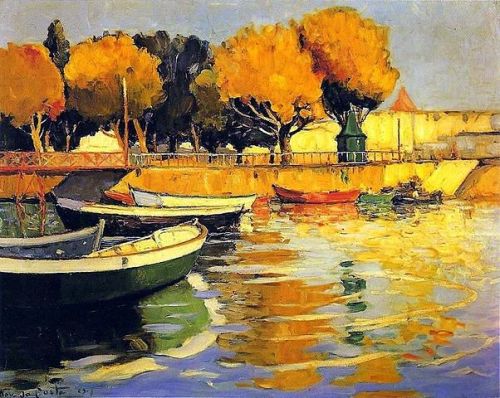 Artist: Ivan Aivazovsky (baptized Hovhannes Aivazovsky) (1817 – 1900)
Artist: Ivan Aivazovsky (baptized Hovhannes Aivazovsky) (1817 – 1900)
Title: The Ninth Wave
Genre: marine art
Date: 1850
Medium: oil on canvas oil on canvas
Dimensions: height: 2,210 mm (87 in); width: 3,320 mm (10.89 ft)
Collection: Russian Museum
What I love about this painting:
Aivazovsky tells a story here, an epic tale showing the power and emotion of the situation. These sailors are lost at sea; their ship has gone down in a storm and even though the sun is shining in the distance, a wave of catastrophic proportions is bearing down on them.
It’s not the first such wave they’ve survived, and it won’t be the last. But that sun shining in the distances is a beacon, and they cling to hope as desperately as they do their broken mast.
About this painting via Wikipedia:
The title refers to an old sailing expression referring to a wave of incredible size that comes after a succession of incrementally larger waves.
It depicts a sea after a night storm and people facing death attempting to save themselves by clinging to debris from a wrecked ship. The debris, in the shape of the cross, appears to be a Christian metaphor for salvation from the earthly sin. The painting has warm tones, which reduce the sea’s apparent menacing overtones and a chance for the people to survive seems plausible. This painting shows both the destructiveness and beauty of nature. [1]
About the Artist via Wikipedia:
Ivan Aivazovsky was born on 29 July [O.S. 17 July] 1817 in the city of Feodosia (Theodosia), Crimea, Russian Empire. In the baptismal records of the local St. Sargis Armenian Apostolic Church, Aivazovsky was listed as Hovhannes, son of Gevorg Aivazian. He became known as Aivazovsky since c. 1840, while in Italy. He signed an 1844 letter with an Italianized rendition of his name: “Giovani Aivazovsky”.
After meeting Aivazovsky in person, Anton Chekhov wrote a letter to his wife on 22 July 1888 describing him as follows:
Aivazovsky himself is a hale and hearty old man of about seventy-five, looking like an insignificant Armenian and a bishop; he is full of a sense of his own importance, has soft hands and shakes your hand like a general. He’s not very bright, but he is a complex personality, worthy of a further study. In him alone there are combined a general, a bishop, an artist, an Armenian, an naive old peasant, and an Othello.
The house in Feodosia, where Aivazovsky lived between 1845 and 1892. It is now an art gallery.
After traveling to Paris with his wife, in 1892 he made a trip to the United States, visiting Niagara Falls in New York and Washington D.C. In 1896, at 79, Aivazovsky was promoted to the rank of full privy councillor.
Aivazovsky was deeply affected by the Hamidian massacres that took place in the Armenian-inhabited areas of the Ottoman Empire between 1894 and 1896. He painted a number of works on the subject such as The Expulsion of the Turkish Ship, and The Armenian Massacres at Trebizond (1895). He threw the medals given to him by the Ottoman Sultan into the sea and told the Turkish consul in Feodosia: “Tell your bloodthirsty master that I’ve thrown away all the medals given to me, here are their ribbons, send it to him and if he wants, he can throw them into the seas painted by me.” He created several other paintings capturing the events, such as Lonely Ship and Night. Tragedy in the Sea of Marmara (1897).
He spent his final years in Feodosia. In the 1890s, thanks to his efforts a commercial port (ru) was established in Feodosia and linked to the railway network of the Russian Empire. The railway station, opened in 1892, is now called Ayvazovskaya [ru] and is one of the two stations within the city of Feodosia.
Aivazovsky also supplied Feodosia with drinking water. [2]
Credits and Attributions:
IMAGE: File: Hovhannes Aivazovsky – The Ninth Wave – Google Art Project.jpg Hovhannes Aivazovsky – The Ninth Wave – Google Art Project – The Ninth Wave – Wikipedia (accessed January 10, 2024).
[1]Wikipedia contributors, “The Ninth Wave,” Wikipedia, The Free Encyclopedia, https://en.wikipedia.org/w/index.php?title=The_Ninth_Wave&oldid=1160319059 (accessed January 10, 2024).
[2] Wikipedia contributors, “Ivan Aivazovsky,” Wikipedia, The Free Encyclopedia, https://en.wikipedia.org/w/index.php?title=Ivan_Aivazovsky&oldid=1194332468 (accessed January 10, 2024).
 Artist: Mário Navarro da Costa (1883-1931)
Artist: Mário Navarro da Costa (1883-1931)
 Artist: Ivan Aivazovsky (baptized Hovhannes Aivazovsky) (1817 – 1900)
Artist: Ivan Aivazovsky (baptized Hovhannes Aivazovsky) (1817 – 1900)

 Title: “Dunes Under the Sun”
Title: “Dunes Under the Sun” 
 Artist:
Artist: 








